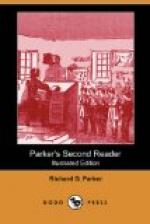13. Sir Walter used to give an amusing account of an incident which befell Maida in one of his chases. “I was once riding over a field on which the reapers were at work, the stooks, or bundles of grain, being placed behind them, as is usual.
14. “Maida, having found a hare, began to chase her, to the great amusement of the spectators, as the hare turned very often and very swiftly among the stooks. At length, being hard pressed, she fairly bolted into one of them.
15. “Maida went in headlong after her, and the stook began to be much agitated in various directions; at length the sheaves tumbled down, and the hare and the dog, terrified alike at their overthrow, ran different ways, to the great amusement of the spectators.”
16. Among several peculiarities which Maida possessed, one was a strong aversion to artists, arising from the frequent restraints he was subjected to in having his portrait taken, on account of his majestic appearance.
17. The instant he saw a pencil and paper produced, he prepared to beat a retreat; and, if forced to remain, he exhibited the strongest marks of displeasure.
18. Maida’s bark was deep and hollow. Sometimes he amused himself with howling in a very tiresome way. When he was very fond of his friends, he used to grin, tucking up his whole lips and showing all his teeth; but this was only when he was particularly disposed to recommend himself.
19. Maida lies buried at the gate of Abbotsford, Sir Walter’s country seat, which he long protected; a grave-stone is placed over him, on which is carved the figure of a dog. It bears the following inscription, as it was translated by Sir Walter:
“Beneath the sculptured
form which late you wore,
Sleep soundly, Maida,
at your master’s door.”
LESSON XXIV.
Gelert.—BINGLEY, altered.
1. I have one more story to tell you about the Highland greyhound. It is an old Welsh story, and shows how extremely dangerous it is to indulge in anger and resentment.
2. In a village at the foot of Snowden, a mountain in Wales, there is a tradition that Llewellyn (pronounced Lewel’lin), son-in-law to King John, had a residence in that neighborhood.
3. The king, it is said, had presented him with one of the finest greyhounds in England, named Gelert. In the year 1205, Llewellyn, one day, on going out to hunt, called all his dogs together; but his favorite greyhound was missing, and nowhere to be found.
4. He blew his horn as a signal for the chase, and still Gelert came not. Llewellyn was much disconcerted at the heedlessness of his favorite, but at length pursued the chase without him. For want of Gelert, the sport was limited; and getting tired, Llewellyn returned home at an early hour, when the first object that presented itself to him, at his castle gate, was Gelert, who bounded, with his usual transport, to meet his master, having his lips besmeared with blood.




